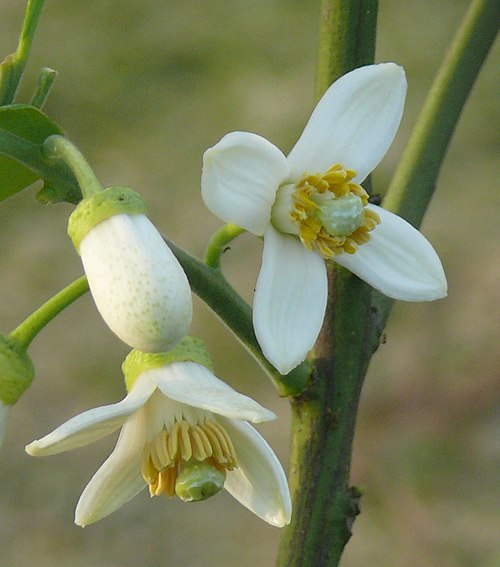Difference between revisions of "Pomelo"
| (One intermediate revision by the same user not shown) | |||
| Line 12: | Line 12: | ||
|features=edible, fruit | |features=edible, fruit | ||
|Temp Metric=°F | |Temp Metric=°F | ||
| − | |image= | + | |image=Citrus grandis - Honey White.jpg |
|image_width=240 | |image_width=240 | ||
}} | }} | ||
| − | The '''pomelo''' (''Citrus maxima'' or ''Citrus grandis'') is a [[citrus]] fruit native to South East Asia. It is usually pale green to yellow when ripe, with sweet white (or, more rarely, pink or red) flesh and very thick pudgy rind. It is the largest citrus fruit, | + | The '''pomelo''' (''Citrus maxima'' or ''Citrus grandis'') is a [[citrus]] fruit native to South East Asia. It is usually pale green to yellow when ripe, with sweet white (or, more rarely, pink or red) flesh and very thick pudgy rind. It is the largest citrus fruit, 15–25 cm in diameter,<ref>[http://www.sfgate.com/cgi-bin/article.cgi?file=/c/a/2004/12/25/HOG7FAFSVC1.DTL&type=printable Growing the granddaddy of grapefruit], SFGate.com, December 25, 2004</ref> and usually weighing 1–2 kg. Other spellings for pomelo include '''pummelo,''' and '''pommelo,''' and other names include '''Chinese grapefruit,''' '''jabong,''' '''lusho fruit,''' '''pompelmous,'''<ref>Dictionary.com</ref> '''Papanas,''' and '''shaddock'''.<ref>After an English sea captain, Captain Shaddock, who introduced the seed to the [[Caribbean|West Indies]] in the 17th century from the [[Malay Archipelago]].</ref> |
The pomelo tastes like a sweet, mild [[grapefruit]], though the typical pomelo is much larger in size than the grapefruit. It has very little, or none, of the common grapefruit's bitterness, but the enveloping membranous material around the segments is bitter, considered inedible, and thus usually discarded. | The pomelo tastes like a sweet, mild [[grapefruit]], though the typical pomelo is much larger in size than the grapefruit. It has very little, or none, of the common grapefruit's bitterness, but the enveloping membranous material around the segments is bitter, considered inedible, and thus usually discarded. | ||
{{Inc| | {{Inc| | ||
| − | Pummelo (possibly contraction of Dutch | + | Pummelo (possibly contraction of Dutch pompelmoes). A generic term including most of the varieties of Citrus grandis. |
The pummelo long grown in the West Indies and the United States comprise a group of very juicy- subglo- bose (not pear-shaped) thin-skinned varieties differing widely from the common pummelos of the East Indies which are usually more or less pear-shaped, thick- skinned, and have a firm pulp. These latter are called shaddocks in the West Indies and United States. These two extremes are well separated in the character of the fruit and also show differences in the leaves and twigs, the pummelos having more or less hairy twigs, leaves downy on the under surface and very broadly winged petioles, while the grapefruits have nearly smooth, slender twigs, leaves smooth on the under surface, and narrower petioles. | The pummelo long grown in the West Indies and the United States comprise a group of very juicy- subglo- bose (not pear-shaped) thin-skinned varieties differing widely from the common pummelos of the East Indies which are usually more or less pear-shaped, thick- skinned, and have a firm pulp. These latter are called shaddocks in the West Indies and United States. These two extremes are well separated in the character of the fruit and also show differences in the leaves and twigs, the pummelos having more or less hairy twigs, leaves downy on the under surface and very broadly winged petioles, while the grapefruits have nearly smooth, slender twigs, leaves smooth on the under surface, and narrower petioles. | ||
Latest revision as of 04:12, 8 March 2010
| Habit | tree
| |
|---|---|---|
| Lifespan: | ⌛ | perennial |
| Exposure: | ☼ | sun |
|---|---|---|
| Water: | ◍ | moderate |
| Features: | ✓ | edible, fruit |
|
Rutaceae > |
Citrus > |
maxima > |
Merr. > |
The pomelo (Citrus maxima or Citrus grandis) is a citrus fruit native to South East Asia. It is usually pale green to yellow when ripe, with sweet white (or, more rarely, pink or red) flesh and very thick pudgy rind. It is the largest citrus fruit, 15–25 cm in diameter,[1] and usually weighing 1–2 kg. Other spellings for pomelo include pummelo, and pommelo, and other names include Chinese grapefruit, jabong, lusho fruit, pompelmous,[2] Papanas, and shaddock.[3]
The pomelo tastes like a sweet, mild grapefruit, though the typical pomelo is much larger in size than the grapefruit. It has very little, or none, of the common grapefruit's bitterness, but the enveloping membranous material around the segments is bitter, considered inedible, and thus usually discarded.
ExpandRead about Pomelo in the Standard Cyclopedia of Horticulture
|
|---|
Cultivation
Propagation
Pests and diseases
Varieties
The Chandler is a Californian variety of pomelo, with a smoother skin than many other varieties. An individual Chandler fruit can reach the weight of one kilogram.
The tangelo is a hybrid between the pomelo and the tangerine. It has a thicker skin than a tangerine and is less sweet. It has been suggested that the orange is also a hybrid of the two fruits.
Gallery
If you have a photo of this plant, please upload it! Plus, there may be other photos available for you to add.
Ipoh pomelos on sale
References
- Standard Cyclopedia of Horticulture, by L. H. Bailey, MacMillan Co., 1963
External links
- w:Pomelo. Some of the material on this page may be from Wikipedia, under the Creative Commons license.
- Pomelo QR Code (Size 50, 100, 200, 500)
- ↑ Growing the granddaddy of grapefruit, SFGate.com, December 25, 2004
- ↑ Dictionary.com
- ↑ After an English sea captain, Captain Shaddock, who introduced the seed to the West Indies in the 17th century from the Malay Archipelago.








